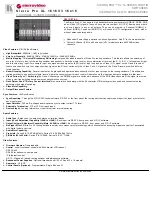
66
Caution:
Do not remove the dust plugs from the SFP module port or the rubber caps from the fiber-optic cable until
you are ready to connect the cable. The plugs and caps protect the SFP module ports and cables from contamination
and ambient light.
6.
Insert the LC cable connector into the SFP module.
Installing 1000BASE-T SFP Modules
The 1000BASE-T (copper) SFP transceiver, see
, has a bale-clasp locking mechanism that secures
the transceiver in the module socket. An RJ-45 connector provides the transceiver's interface point to the network.
Figure 41 1000BASE-T SFP Transceiver
Caution:
To comply with GR-1089 intrabuilding lightning immunity requirements, you must use grounded, shielded,
twisted-pair, CAT5 cabling.
When connecting to a 1000BASE-T-compatible server, workstation, or router, use four twisted-pair, straight-through
CAT5 cabling for the SFP transceiver port. When connecting to a 1000BASE-T-compatible switch or repeater, use four
twisted-pair, crossover CAT5 cabling.
To install a 1000BASE-T SFP transceiver:
1.
Attach an ESD-preventive wrist strap to your wrist and to the ESD ground connector on the chassis or to a properly
grounded bare metal surface.
Caution:
To avoid ESD damage, handle the SFP by its sides; do not touch the connector pins.
2.
Remove the new 1000BASE-T SFP module from its protective packaging.
3.
Check the markings on the SFP transceiver to verify that you have the correct model for your network.
4.
Position the SFP transceiver in front of the port socket opening.
Note:
Different Cisco devices have different SFP transceiver socket configurations. Your Cisco device might require
that the SFP transceiver be installed with the bale-clasp either in a latch-up or a latch-down orientation. Verify that
the SFP transceiver is oriented correctly when you position it in front of the port socket.
5.
With the bale-clasp closed (locked), slide the SFP transceiver into the socket until you feel it snap in place in the
socket. You may hear an audible click as the SFP transceiver latch engages in the socket (
6.
Connect the network interface cable RJ-45 plug to the SFP RJ-45 connector.
7.
Observe the port status LED:
—
Green indicates that the SFP transceiver and the target device established a link.
1
RJ-45 connector
3
Open bale-clasp latch (unlocked)
2
Closed bale-clasp latch mechanism (locked)
Содержание IE 2000
Страница 26: ...26 ...
Страница 77: ...77 Figure 45 Serial Number Location for the Cisco IE 2000 Switches 332705 781 00736 01 SN XXXNNNNXXXX ...
Страница 78: ...78 ...
Страница 94: ...94 ...
















































